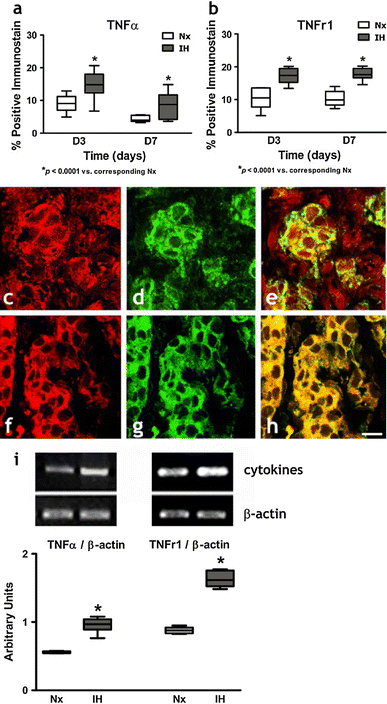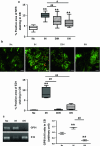Chronic intermittent hypoxia induces local inflammation of the rat carotid body via functional upregulation of proinflammatory cytokine pathways
- PMID: 22187044
- PMCID: PMC3278607
- DOI: 10.1007/s00418-011-0900-5
Chronic intermittent hypoxia induces local inflammation of the rat carotid body via functional upregulation of proinflammatory cytokine pathways
Abstract
Maladaptive changes in the carotid body (CB) induced by chronic intermittent hypoxia (IH) account for the pathogenesis of cardiovascular morbidity in patients with sleep-disordered breathing. We postulated that the proinflammatory cytokines, namely interleukin (IL)-1β, IL-6 and tumor necrosis factor (TNF)-α, and cytokine receptors (IL-1r1, gp130 and TNFr1) locally expressed in the rat CB play a pathophysiological role in IH-induced CB inflammation. Results showed increased levels of oxidative stress (serum 8-isoprostane and nitrotyrosine in the CB) in rats with 7-day IH treatment resembling recurrent apneic conditions when compared with the normoxic control. Local inflammation shown by the amount of ED1-containing cells (macrophage infiltration) and the gene transcripts of NADPH oxidase subunits (gp91(phox) and p22(phox)) and chemokines (MCP-1, CCR2, MIP-1α, MIP-1β and ICAM-1) in the CB were significantly more in the hypoxic group than in the control. In addition, the cytokines and receptors were expressed in the lobules of chemosensitive glomus cells containing tyrosine hydroxylase and the levels of expressions were significantly increased in the hypoxic group. Exogenous cytokines elevated the intracellular calcium ([Ca(2+)](i)) response to acute hypoxia in the dissociated glomus cells. The effect of cytokines on the [Ca(2+)](i) response was significantly greater in the hypoxic than in the normoxic group. Moreover, daily treatment of IH rats with anti-inflammatory drugs (dexamethasone or ibuprofen) attenuated the levels of oxidative stress, gp91(phox) expression and macrophage infiltration in the CB. Collectively, these results suggest that the upregulated expression of proinflammatory cytokine pathways could mediate the local inflammation and functional alteration of the CB under chronic IH conditions.
Figures









Similar articles
-
Chronic hypoxia upregulates the expression and function of proinflammatory cytokines in the rat carotid body.Histochem Cell Biol. 2008 Sep;130(3):549-59. doi: 10.1007/s00418-008-0437-4. Epub 2008 May 1. Histochem Cell Biol. 2008. PMID: 18446360
-
Upregulation of a local renin-angiotensin system in the rat carotid body during chronic intermittent hypoxia.Exp Physiol. 2014 Jan;99(1):220-31. doi: 10.1113/expphysiol.2013.074591. Epub 2013 Sep 13. Exp Physiol. 2014. PMID: 24036592
-
Adaptation to chronic hypoxia involves immune cell invasion and increased expression of inflammatory cytokines in rat carotid body.Am J Physiol Lung Cell Mol Physiol. 2009 Feb;296(2):L158-66. doi: 10.1152/ajplung.90383.2008. Epub 2008 Oct 31. Am J Physiol Lung Cell Mol Physiol. 2009. PMID: 18978039 Free PMC article.
-
Expressions of angiotensin and cytokine receptors in the paracrine signaling of the carotid body in hypoxia and sleep apnea.Respir Physiol Neurobiol. 2015 Apr;209:6-12. doi: 10.1016/j.resp.2014.09.014. Epub 2014 Oct 3. Respir Physiol Neurobiol. 2015. PMID: 25266394 Review.
-
Inflammation and oxidative stress during intermittent hypoxia: the impact on chemoreception.Exp Physiol. 2015 Feb 1;100(2):149-55. doi: 10.1113/expphysiol.2014.079525. Epub 2015 Jan 14. Exp Physiol. 2015. PMID: 25523440 Review.
Cited by
-
Monocyte Chemoattractant Protein 1 (MCP-1) in obesity and diabetes.Cytokine. 2012 Oct;60(1):1-12. doi: 10.1016/j.cyto.2012.06.018. Epub 2012 Jul 4. Cytokine. 2012. PMID: 22766373 Free PMC article. Review.
-
Possible Molecular Mechanisms of Hypertension Induced by Sleep Apnea Syndrome/Intermittent Hypoxia.Life (Basel). 2024 Jan 22;14(1):157. doi: 10.3390/life14010157. Life (Basel). 2024. PMID: 38276286 Free PMC article. Review.
-
The carotid body: A novel key player in neuroimmune interactions.Front Immunol. 2022 Oct 24;13:1033774. doi: 10.3389/fimmu.2022.1033774. eCollection 2022. Front Immunol. 2022. PMID: 36389846 Free PMC article. Review.
-
Roles and Mechanisms of Obstructive Sleep Apnea-Hypopnea Syndrome and Chronic Intermittent Hypoxia in Atherosclerosis: Evidence and Prospective.Oxid Med Cell Longev. 2016;2016:8215082. doi: 10.1155/2016/8215082. Epub 2016 May 16. Oxid Med Cell Longev. 2016. PMID: 27293515 Free PMC article. Review.
-
Chemoreflexes, sleep apnea, and sympathetic dysregulation.Curr Hypertens Rep. 2014 Sep;16(9):476. doi: 10.1007/s11906-014-0476-2. Curr Hypertens Rep. 2014. PMID: 25097113 Free PMC article. Review.
References
Publication types
MeSH terms
Substances
LinkOut - more resources
Full Text Sources
Medical
Miscellaneous

